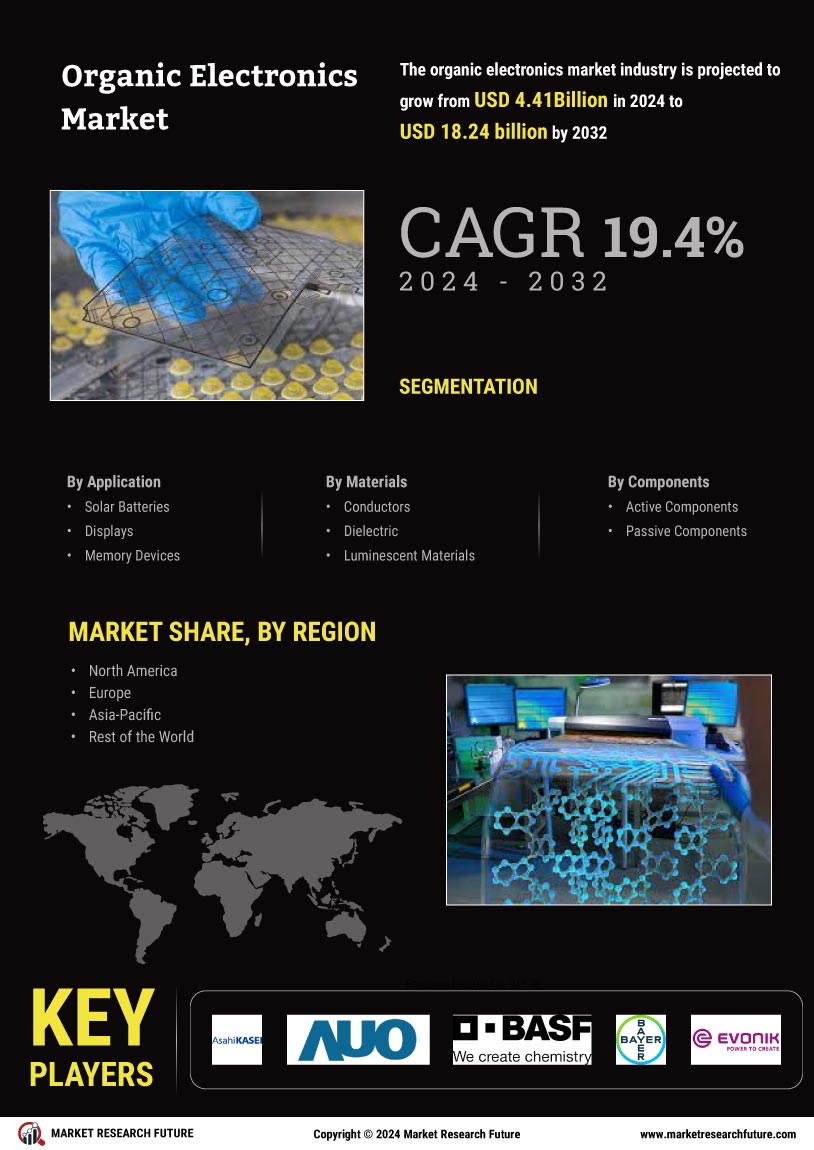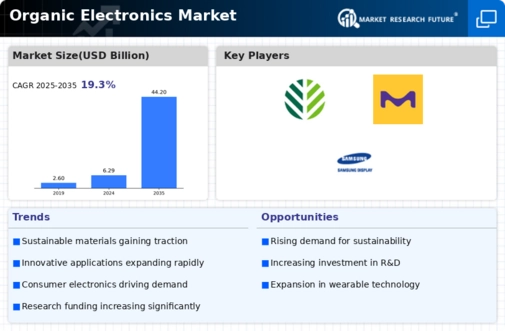Market Growth Projections
The Global Organic Electronics Market Industry is poised for remarkable growth, with projections indicating a market value of 6.29 USD Billion in 2024 and an anticipated increase to 44.2 USD Billion by 2035. This growth trajectory suggests a robust compound annual growth rate (CAGR) of 19.39% from 2025 to 2035. The expansion is driven by various factors, including technological advancements, increasing consumer demand for innovative products, and the integration of organic electronics in diverse applications. As the industry evolves, stakeholders are likely to witness substantial opportunities for investment and development, positioning organic electronics as a key player in the future of technology.
Emerging Applications in Healthcare
The Global Organic Electronics Market Industry is exploring emerging applications in the healthcare sector, particularly in medical devices and diagnostics. Organic electronics offer unique advantages, such as biocompatibility and the potential for low-cost manufacturing. Innovations in organic sensors and wearable health monitors are gaining traction, providing real-time health data and improving patient outcomes. As healthcare systems increasingly adopt digital solutions, the demand for organic electronic devices is likely to grow. This trend could significantly impact the market, contributing to its expansion as healthcare providers seek efficient and effective technologies to enhance patient care.
Rising Demand for Flexible Displays
The Global Organic Electronics Market Industry experiences a notable surge in demand for flexible displays, driven by advancements in organic light-emitting diode (OLED) technology. These displays are increasingly utilized in smartphones, tablets, and wearable devices due to their lightweight and bendable nature. In 2024, the market is projected to reach 6.29 USD Billion, reflecting a growing consumer preference for innovative display solutions. As manufacturers continue to invest in research and development, the flexibility and efficiency of OLEDs are expected to enhance their market penetration, potentially leading to a substantial increase in the overall market size by 2035.
Advancements in Organic Photovoltaics
The Global Organic Electronics Market Industry is witnessing significant advancements in organic photovoltaics (OPVs), which are gaining traction as a viable alternative to traditional solar cells. OPVs offer advantages such as lightweight, flexibility, and the potential for low-cost production. As the technology matures, the efficiency of these solar cells is expected to improve, making them more competitive in the renewable energy market. The increasing adoption of OPVs in building-integrated photovoltaics and portable electronic devices is likely to contribute to the market's growth. By 2035, the market for organic photovoltaics could play a crucial role in achieving the projected market size of 44.2 USD Billion.
Sustainability and Eco-Friendly Materials
The Global Organic Electronics Market Industry is significantly influenced by the rising emphasis on sustainability and the use of eco-friendly materials. As consumers become more environmentally conscious, manufacturers are increasingly adopting organic materials in electronic devices. This shift not only reduces the environmental impact but also aligns with global sustainability goals. The incorporation of biodegradable materials in organic electronics is likely to attract a broader customer base, thereby driving market growth. The anticipated CAGR of 19.39% from 2025 to 2035 indicates a robust expansion trajectory, as companies strive to meet the demand for greener alternatives in the electronics sector.
Integration of Organic Electronics in IoT Devices
The Global Organic Electronics Market Industry is experiencing a transformative shift with the integration of organic electronics in Internet of Things (IoT) devices. The lightweight and flexible nature of organic components makes them ideal for various IoT applications, including smart home devices and wearables. As the IoT ecosystem expands, the demand for organic electronics is expected to rise, driven by the need for efficient and cost-effective solutions. This trend is likely to enhance the overall market landscape, with projections indicating a substantial increase in market value as more devices incorporate organic technologies. The anticipated growth aligns with the broader trend of digital transformation across industries.
















Leave a Comment